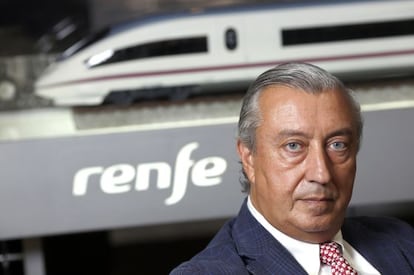“Every day we have 4,600 trains running that are completely safe”
Renfe chief Julio Gómez-Pomar answers questions about the fatal accident in Galicia


The president of Renfe, the state-owned railway operator, speaks cautiously. Julio Gómez-Pomar says he still does not have enough information to assess the causes of the train crash that killed 79 people outside Santiago de Compostela on the evening of July 24.
In this interview with EL PAÍS, conducted before it emerged that the train driver was on the phone with a Renfe employee at the time of the accident, the chairman detailed the safety systems in place in the Spanish railway network. He also attempted to answer the question that has been on many people's minds for over a week: Is it normal for a train driver to have so much leeway without some kind of automated control system to take over in the event of excess speed, as was the case here?
Question. Are there enough safety measures in place when a momentary lapse by the driver can cause a tragedy resulting in 79 fatalities?
Answer. The safety system used by this train, ASFA (Automatic Braking and Announcement of Signals, in its Spanish acronym), was rolled out in Spain a long time ago, as in most European countries. Its signaling requirements are met, its rules are observed... Engineers and safety experts in Spain and abroad have decided that it is adequate for these speeds and these tracks.
Q. With this system, speed depends solely on the driver. Why is it safer to go at 300km/h to Barcelona on an AVE (high-speed train), which has an automatic speed control mechanism than at 200km/h to Santiago?
A. Both routes are equally safe. This is not my personal belief, but that of all technical services on the railway lines.
Q. But the ERTMS (European Rail Traffic Management System) on the AVE, which pulls the brakes on a train if the driver goes over the speed limit, barely leaves any margin for human error.
The ERTMS is the proper system for high-speed rail and the other system is adequate for the rest"
A. The high-speed lines carry 12 million passengers each year. The networks that are not high-speed carry 448 million people. Every day, we have 4,600 trains running with over 1.6 million passengers who are completely safe. The ERTMS is the proper system for high-speed rail and the other system is adequate for the rest.
Q. On trains that are not considered AVE but still reach speeds of 200 km/h, wouldn't it be possible to control speed through beacons if the ERTMS is deemed too expensive?
A. The main thing is to heed the recommendations of the Public Works Ministry's accident committee. They're the ones who will analyze the lessons we should learn from this tragic accident so it does not occur again.
Q. Did the driver get some kind of warning that he was going too fast through the ASFA system?
A. No. The ASFA beacons provide information about two issues. If the train goes faster than 200km/h, the beacon stops the train. If the tracks are occupied, a red or yellow signal is activated, and may halt the train. But if the train goes under 200km/h, the speed is left up to the driver.
Q. What signals were available to him?
A. Near kilometer 80 there is a trackside signal warning that the A Grandeira junction is coming up. There is also a light signal overhead telling the driver that he is going to run on the Santiago tracks rather than veer off to Vigo. He also has a sign indicating that a tunnel is coming up. All of these elements indicate that at this point, speed should be reduced. According to the training that the drivers get, this is the most relevant signal on this track.
Near kilometer 80 there is a trackside signal warning that the A Grandeira junction is coming up"
Q. Why is there no sign indicating that the speed limit on this section of track is 80 km/h?
A. Railway signaling is different from road signaling, and it is designed by technicians, the people who know the tracks best. It is understood that existing signals, the track map and the speed chart are enough for this section of track.
Q. Do drivers have a physical copy of the map and speed chart, or do these also show up on a screen?
A. They are paper documents.
Q. Is that curve considered an especially dangerous spot?
A. The railway route is designed by engineers. They design the route's curve radius and establish speeds depending on the radius. On this bend, the speed was the appropriate one for its radius, and the radius is an admissible one in railroad circulation.
Q. When will the ERTMS be operational on this section of track?
A. The manufacturer asked us for a few months to work out the kinks and we are starting to conduct testing. We do it at night, when the tracks are closed off.
Q. In any case, the ERTMS does not reach the Santiago station. The system only goes as far as kilometer 80, which is 4.3 kilometers before the site of the accident. Why is that?
A. The Madrid-Galicia route will be high speed in 2018 if deadlines are met. You have to go section by section. This route aims to go all the way to Vigo and A Coruña, meaning that it will have to be remodeled when the definitive high-speed route is laid out.
Tu suscripción se está usando en otro dispositivo
¿Quieres añadir otro usuario a tu suscripción?
Si continúas leyendo en este dispositivo, no se podrá leer en el otro.
FlechaTu suscripción se está usando en otro dispositivo y solo puedes acceder a EL PAÍS desde un dispositivo a la vez.
Si quieres compartir tu cuenta, cambia tu suscripción a la modalidad Premium, así podrás añadir otro usuario. Cada uno accederá con su propia cuenta de email, lo que os permitirá personalizar vuestra experiencia en EL PAÍS.
¿Tienes una suscripción de empresa? Accede aquí para contratar más cuentas.
En el caso de no saber quién está usando tu cuenta, te recomendamos cambiar tu contraseña aquí.
Si decides continuar compartiendo tu cuenta, este mensaje se mostrará en tu dispositivo y en el de la otra persona que está usando tu cuenta de forma indefinida, afectando a tu experiencia de lectura. Puedes consultar aquí los términos y condiciones de la suscripción digital.
Últimas noticias
The complicated life of Francesca Albanese: A rising figure in Italy but barred from every bank by Trump’s sanctions
How Japan is trying to avert ‘digital defeat’
Half of Scotland is in the hands of 420 property owners
Reinhard Genzel, Nobel laureate in physics: ‘One-minute videos will never give you the truth’
Most viewed
- Pablo Escobar’s hippos: A serious environmental problem, 40 years on
- Why we lost the habit of sleeping in two segments and how that changed our sense of time
- Charles Dubouloz, mountaineering star, retires at 36 with a farewell tour inspired by Walter Bonatti
- Reinhard Genzel, Nobel laureate in physics: ‘One-minute videos will never give you the truth’
- The Florida Keys tourist paradise is besieged by immigration agents: ‘We’ve never seen anything like this’








































